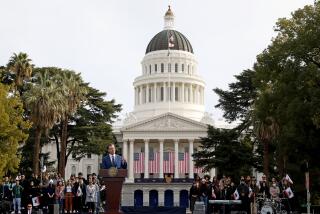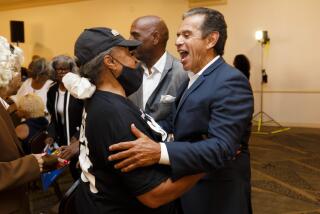Column: Fourth term for Gov. Brown needs bold ideas

Gov. Jerry Brown enjoys a unique position that no California governor has been in for 68 years. He is a virtual shoo-in for reelection.
That gives him an extremely rare opportunity to rise above conventional political rhetoric and open a substantive dialogue with voters about the state’s future direction.
In a cakewalk, there’s little risk of tripping.
A California governor hasn’t had such an opening since immediately after World War II. In 1946, Republican Earl Warren won both major parties’ nominations and was reelected in November with nearly 92% of the vote.
That was under California’s old cross-filing system, which allowed candidates to run in both major party primaries. It was a boon to Republicans. And when Democrat Pat Brown — Jerry’s dad — was elected governor and his party took over the Legislature in 1959, cross-filing was abolished.
Since then, incumbents have always faced credible opponents and been forced to run all-out.
But Jerry Brown — 76 next month — is super strong. Without working up a sweat, he already has banked $17 million-plus in campaign contributions from labor and business alike. His job approval rating among registered voters was 58% in the latest Field Poll.
His Republican opposition is little known, with little money and little to sell. Investment banker Neel Kashkari’s claim to fame is once being the federal bailout czar. Tea party Assemblyman Tim Donnelly is best known for being nabbed by airport security toting a loaded handgun.
So Brown can coast. And he plans to.
“It will be the un-campaign,” says Brown political spokesman Dan Newman. “He’ll govern. People aren’t begging for political stunts and prop-filled theater.”
That certainly was the scene last week when Brown made his candidacy official. He showed up unannounced at the Alameda County elections office and took out candidacy papers. No TV choreographing. Newman merely snapped a picture on his cellphone and tweeted it with a Brown-written announcement message.
The next day, the governor returned with a few reporters to the dimly lit basement office and turned in the signed document.
It’s the old Rose Garden strategy employed by presidents trying to avoid ambush along the campaign trail. But Brown need not fear the trail. And he doesn’t need to hide.
There’s plenty to tout about Brown’s third term: Finally, there’s a deficit-free, balanced state budget. He kept his promise not to raise taxes without the voters’ approval, which they gave. He transferred more control to local schools and shifted money to educate the most disadvantaged. He began lowering the prison population without a mass release of violent criminals.
But he has vulnerabilities: His proposed bullet train looks like a boondoggle with no funding stream for its $68-billion sticker price. His twin-tunnels water project would tear up the picturesque Sacramento-San Joaquin River Delta and is very costly and controversial.
All that returns me to my earlier point: This governor has a rare opportunity to campaign on a futuristic agenda of bold solutions to California’s long-range problems.
What if, for example, Brown called for launching a massive desalination program that would solve California’s water scarcity forever? Why has the state been so slow trying to tap nature’s gift: the ocean? Local regions — namely San Diego — are well ahead of Sacramento.
Desalination used to be cost-prohibitive. But technology is lowering the cost as the demand for water rises. How about shifting proposed tunnel financing into a desalination program?
That $9 billion in bullet train bonds approved by voters? What if the voters were asked for permission to spend them instead on upgrading conventional rail service in California, reliable lines such as exist on the East Coast? They existed here when Brown was growing up.
We also had very affordable public higher education and somehow need to return to that — for everyone, including middle-class students, so they’re not stuck for decades with college loans.
California badly needs to expand its electricity grid to carry all the renewable energy — especially solar — that Brown likes to promote. Why not use cap-and-trade pollution fees he proposes for the bullet on a grid instead?
Decades ago, Brown was lampooned as “Gov. Moonbeam” for proposing that California launch its own communications satellite. Maybe that’s a creative idea whose time has come.
The business climate was much friendlier when Pat Brown was governor. Environmental protections were needed, and Ronald Reagan and Jerry Brown enacted them. But in recent years they’ve been abused by labor as a unionizing tool and by business to block competition. Economic development has suffered. Reform is long overdue.
California’s tax structure is an unstable roller coaster and needs some leveling. Unlike Jerry Brown, his father didn’t soak the rich. In the long run, that’s unsustainable. Some will flee in lifeboats.
After contributing to Proposition 13’s unintended consequences 36 years ago, Gov. Brown’s final act could be to repair the property tax measure’s flaws.
There’s a lot of futurism that Brown could talk to voters about without fear of being rejected for a record fourth term.
That would require him to rethink some views. But, after all, it was Brown who used to love quoting Ralph Waldo Emerson: “A foolish consistency is the hobgoblin of little minds.”
“This is a governor who can actually shape the arc of history, as opposed to being pulled along by ordinary politics,” says Democratic consultant Chris Lehane. “That’s a pretty cool thing.”
But Brown is pretty cautious. He has acquired that trait over the years. And it’s hard to argue with success. Yet this is his chance to be a true visionary — and win a voter mandate to realize his vision.
More to Read
Sign up for Essential California
The most important California stories and recommendations in your inbox every morning.
You may occasionally receive promotional content from the Los Angeles Times.










